How Mark Metternich captures Light in Landscape Photography
Over the last decade I have had the awesome privilege of capturing some of the most dramatic light in landscape photography. In order to consistently capture stunning landscape photos in some pretty usual light, I travel over 300 days a year. But traveling alone is not enough. Here are few landscape photography tips that can vastly improve your chances of capturing the dramatic light that makes your viewers go “WOW”.
#1 – Become a Serious Student of the Weather
This critical tip mostly means studying a wide array of websites and apps related to weather. When I become interested in targeting a specific area for landscape photos, the first question that comes to mind is “When is the weather at its best for the conditions that produce dramatic light in landscape photography that I want to capture?” For instance, when I started photographing the southwest desert, the first thing I did was check online precipitation charts to determine the time frame of the best chances for clouds. This information is easily found with simple Google searching.
The next thing I did was study the best season for lightning and thunderstorm activity. If you browse my online portfolio, you’ll see a solid body of work that includes lightning strikes in the landscape photos. Also, aside from countless new smart phone apps, I always check and compare weather reports for a landscape photography location before I invest the precious time and resources to travel there to attempt a shoot. Sites such as Weather.com, Weather Underground, Windguru, and NOAA, along with various radar projections can help you know what the weather might do at the specific location you are targeting. People often ask me on what sources I rely. I rely on them all. Looking at a wide range, I can usually detect the general trend of what the weather is heading toward or away from.
#2 – Respond to the Light… It won’t Respond to You
Making intuitive weather decisions is critical in this work. Once you’ve studied all your sources, it’s now time to make a decision. This means I constantly study the weather and employ the critical flexibility to respond to it instead of thinking it might respond to us. This dramatically ups our chances of getting stunning light in landscape photography. Using this method is how I caught lightning strikes over Crater Lake with dramatic sunset lighting and well as my award winning images Wotan’s Crescendo and Throne of Light with a rainbow, mammoth clouds, lightening, and crazy colors all in the same scene. People have often remarked, “You were so lucky to capture that image.” I believe luck favors the prepared. It’s almost always the best approach to landscape photography.
#3 – Invest in Fitness
This means fitness and the right clothing gear. I’m always amazed at how often people are not willing to budget fitness into their landscape photography equation. The problem is that some great places are not always easy to get to… especially when carrying many pounds of photography gear. Landscape photography is certainly not an endurance sport but we can learn a lot from an athletic approach by simply getting more fit before a major outing.
The general rule is to do slowly progressive exercise that relates to what you are actually going to do out in the field. What do landscape photographers do? We hike, carry a backpack, go up and down hills, and sometimes cross rivers or scramble. So, the goal is to do exercise that most closely resembles that type of activity. Why? Because as it has been said that “preparation helps to avoids desperation.”
#4 – Shoot More, Spend Less
To up our odds for capturing unique, rare, and wild atmospheric light in landscape photography, we must get out into the field to photograph more often. So, find a way to spend less money on landscape photography gear and more money on travels. Years ago, I remember reading a forum post where a landscape photographer was answering a question about what lens was the best. He basically said they are all good enough to capture great landscape photos and that the real thing is not the gear (sorry gearheads!); it’s about giving yourself more opportunities to capture landscape photos in natural light.
Sure, if you’re rich, buy all the gear you want. But the real bottom line here is that the more you shoot, the luckier you get. If it’s a decision between a new camera body and a $2,000-$3000 trip somewhere special for a few weeks, I’ll choose the trip ever time.
#5 – Weather protection for Photography Gear
What’s going to happen when the torrential downpour starts? Well for one, your camera may get drenched. Are you going to let this stop you from shooting? In Patagonia, my workshop participants photographed in 70 MPH winds; this didn’t stop anyone! Although that was extremely unusual (most of my workshops are quite mild in comparison), it drives home the fact that we need to be prepared for anything. Some of those peaceful waterfall landscape photography scenes you see on my website can be quite deceiving. Many were photographed in torrential downpours during long exposures in very difficult conditions. Sometimes under an umbrella and often with one of those plastic shower caps over the top of my camera.
There are so many scenarios to think though and my advice is to think through them before hitting the road. If in doubt about what you might face, contact one of your favorite landscape photographers and ask them how they do it. Often there’s no better way to get tips.
#6 – Be Ready for Challenging Weather
Along with crazy lighting comes crazy and challenging weather conditions. Are you ready for torrential rain, hail, high winds, lightning, flash floods, uncomfortable temperatures, and potentially hazardous driving conditions? You better be! When nature shows her glory, you certainly don’t want to be caught unprepared. It helps to think through what you might be up against.
As far as outdoor gear goes, it’s a critical tip to make sure you have adequate clothing and broken-in comfortable waterproof hiking boots. Always sitting within reach in my rig are various layers of clothes, jackets, rain jackets, a down jacket (for extreme cold), rain pants, warm new/wool hiking socks, hiking/trekking poles, waterproof boots, chest waders, a beanie, sunglasses, gloves, sunscreen, and much more.
#7 – Master Post-processing for Landscape Photography
Whether it’s Lightroom, Camera Raw, or Photoshop, post-processing skills are a critical must for bringing out the details, colors and light in landscape photography. As I see it, this is the other side of the shooting coin which be embraced head-on, not avoided or dreaded. The great news is that it’s easier than ever before to get excellent post-processing training. Many of the best landscape photographers offer their services to help others get up to speed. From video tutorials to private Skype lessons to workshops, the explosion of the information age of the Internet provides ample access to great training.
My main tip for people approaching this giant learning curve is the very thing I would do if I was facing it… seek out landscape photographers (whose work and style you admire) and invest in their services. By doing so, beginner landscape photographers are up to speed with their skills at about 1/4 of the time it took people like myself in previous times.
#8 – Love What You Do
Passion is the wellspring of life and, if consistently tapped into, it has the potential of catapulting us forward in life. Once in a awhile I receive an email by a photography follower asking me how I motivate myself to be out in the wild for long periods of time facing the long drives, uncomfortable conditions, lack of sleep, lack of conveniences, dealing with bears, snow, rain, and such. I often think to say, “If you’re asking the question, then you may not have what it takes to do this.” I don’t mean this in an arrogant way. What I mean is that my passion for landscape photography supersedes my obstacles.
So, if you don’t have a deep burning drive to do this work, I would say it may be your best option in life. It may be advisable to spend some quality time soul-searching to find your deepest desires. If you do, you’ll then begin to find the passion to accomplish them. For me, landscape photography and philanthropic work are my two main passions.
#9 – Take Chances
Over the last 14 years of photographing landscapes, I’ve finally come to a quiet confidence that when faced with many shooting options, trusting my gut feelings usually doesn’t lead me astray. Sometimes we are trying to make something work for one reason or another but our gut is saying something else. I’m talking about intuition here… where your “gut” is telling you something that your brain is sometimes overriding or drowning out. Like the following internal dialogue: “Mark, I know you want that great landscape photo over there but I think the light for landscape photography is going to explode over in the other direction!”
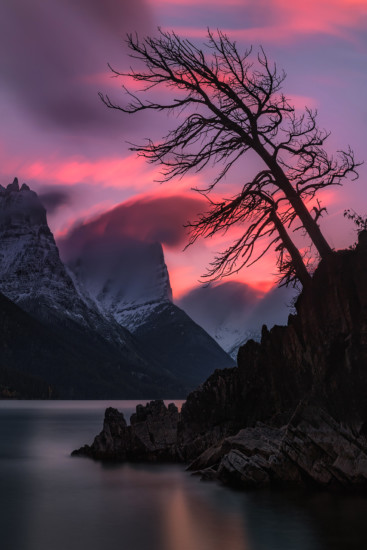
Stunning light in Landscape Photography at St. Mary’s Lake, Glacier National Park by Mark Metternich
It is best NOT to ignore these types of feelings when you are trying to photograph dramatic light in nature. It takes years of making plenty of mistakes to find out if your individual intuitive gut reactions are right more than not.
#10 – Face Your fears
Many years ago as I followed the work of one of my favorite landscape photographers. I noticed that a lot of his shots were out in the wild, among bears and many great unknowns. In the earliest days, just being by myself in the forest at night was scary. But to really get out and have awesome adventures chasing dramatic light for landscape photography, fear must be constantly faced! The key is to start small and face those fears one at a time. Only you know what they are. But you cannot let them rule you; you must rule over them.
I will never forget the first time I stayed over night in a tent in grizzly territory. It scared the heck out of me. Eventually I got better at it. Of course I come prepared with bear mace/pepper spray and more! But the bottom line is that I had to face these things one at a time, head on to capture the landscape photos that you see in my portfolio.
So, whether it’s going out by yourself for the first time, overnight camping by yourself, hiking in grizzly territory for the first time, or standing in the face of electrical storms, it takes courage to face our fears. But most importantly, it’s good to know that this courage can be developed!
So go out, enjoy nature, and maybe employ some of the tips here. I wish you great success in your own photographic endeavors.

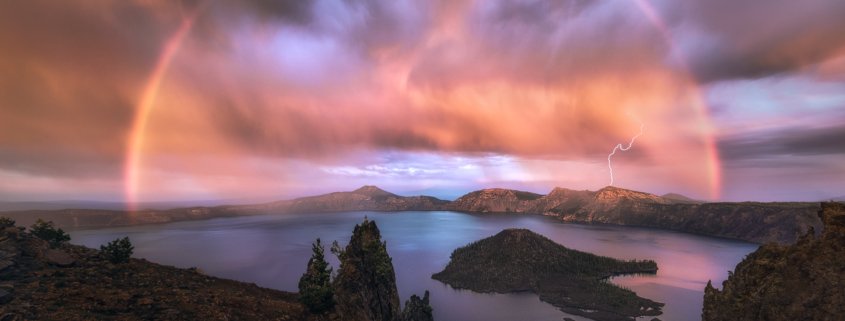

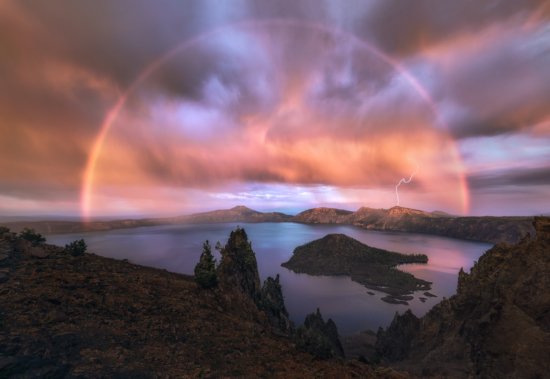
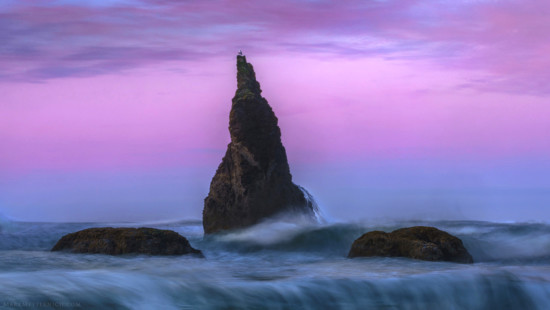
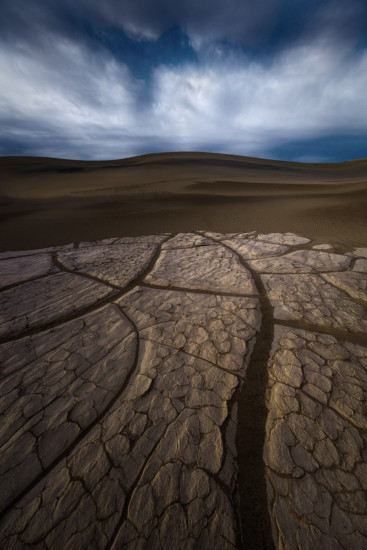
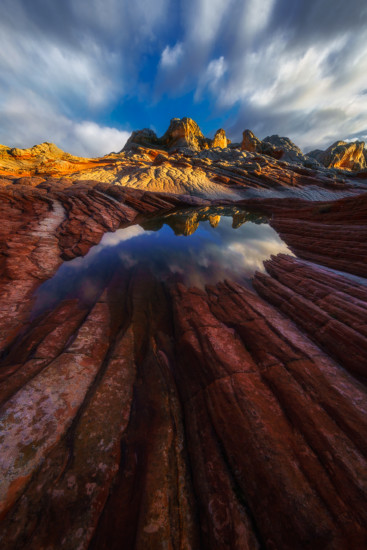




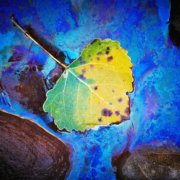



Great article Mark, I definitely think getting out as much as possible and trying new things is one of the best ways of improving your images. Couple that with learning as much as possible about post processing, and it will put you in the best position to produce stunning images similar to the great examples in your post.
Love the rainbow over crater lake by the way :)
Thanks Mark, I really enjoyed reading your tips. I live in the Pacific Northwest, and sometimes avoid the bad weather just because I’m tired of getting wet! You inspired me to use my rain gear (that, by the way, I do keep in my car) and hit the trail more often in inclement weather.
That is awesome Lisa. Let nothing stop you! :)
You are an inspiration Mark. Always happy to see your work.
Thank you very much Waheed! Great light to you!